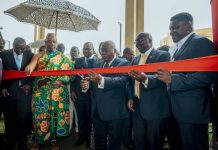GEORGIA—United States of America, February 2022/ — Carbon capture, utilization, and storage (CCUS) is a crucial pathway to lowering carbon emissions from power generation to near-zero levels; GE-led project includes collaboration with Southern Company, Linde, BASF, and Kiewit.
GE Gas Power (www.GE.com/Gas-Power) will develop a front-end engineering design (FEED) study with advanced technology and control concepts to integrate Southern Company subsidiary Alabama Power’s James M. Barry Electric power plant with Linde’s Gen 2 carbon capture solution based on BASF’s OASE® blue gas treatment technology; Study will serve as a template for lowering carbon emissions for other 7F gas power plants worldwide
GE Gas Power (NYSE: GE) announced that the company’s front-end engineering design (FEED) study “Retrofittable Advanced Combined Cycle Integration for Flexible Decarbonized Generation” will receive $5,771,670 in federal funding from the U.S. Department of Energy’s (DOE) Office of Fossil Energy and Carbon Management following successful completion of the award negotiation phase.
This funding is focused on carbon capture, utilization, and storage (CCUS) for power generation applications with a goal of commercial deployment by 2030. GE Gas Power will work with Southern Company, Linde, BASF, and Kiewit to develop a detailed plan for integrating carbon capture technologies with a natural gas combined cycle plant to capture approximately 95 percent of carbon dioxide emissions generated.
The FEED study will be focused on Southern Company subsidiary Alabama Power’s James M. Barry Electric Generating Plant, located in Bucks, Alabama, which is powered by two GE 7F.04 gas turbines, part of GE’s 7F gas turbine fleet, the largest gas turbine fleet in North America. GE will research advanced technology and control concepts to integrate the combined cycle power plant with Linde’s Gen 2 carbon capture solution based on BASF OASE® blue technology.
The project will also include gas and steam turbine equipment enhancements to improve the carbon capture process, with a goal of reducing the impact of the carbon capture process on the power plant’s output, performance, and equipment cost.
With the goals of reliability, load flexibility, and significant reduction in carbon emissions, this retrofittable solution can be applicable to other power plant sites and serve as a template for lowering carbon emissions across more than 1,500 F-Class gas turbines worldwide, which currently deliver up to approximately 280 gigawatts of electricity daily.
“We are committed to leading a more sustainable power industry that will provide the world with the affordable, reliable, and less carbon-intense electricity it needs today, while maintaining laser-focused on researching, developing, and demonstrating the technologies that will be required for the future,” said Scott Strazik, CEO of GE Power. “GE is pleased that the Department of Energy has recognized the importance of this study and grateful for their support.
…We look forward to joining forces with Southern Company, Linde, BASF and Kiewit to execute this study focused on the integration of carbon capture technologies on a fully functional natural gas combined cycle power plant to help lower the cost of carbon capture and improve the operability and flexibility of the integrated plant.”
Due to the complexity of the integration of CCUS technologies into an existing natural gas power plant, this FEED study – a detailed blueprint and operating business guide – will represent a pre-requisite for future construction projects and it can accelerate commercial deployment of other projects.
With proven expertise in natural gas combined cycle plant engineering, operability, and plant integration, GE will lead the full-scale integration of the study with the goal of preserving the attributes of a natural gas combined cycle plants that are critical to enable a renewable energy-based future including dispatchability, lower carbon intensity, high flexibility and reliability, and low capital cost.
“For the success of this study, the collaboration with Southern Company and Linde, BASF and Kiewit is crucial,” said John Catillaz, Director of Decarbonization – Marketing, GE Gas Power. “To develop a sustainable and viable carbon capture solution integrated into the existing power plant, we will go beyond the scope of the study to consider the economics and the performance of the plant holistically, including a plan for the transportation and storage of the captured carbon dioxide emissions.”
“As a leader in energy innovation, Southern Company is advancing CCUS as part of a portfolio of technologies to achieve a net-zero future, while providing customers with clean, safe, reliable and affordable energy,” said Dr. Mark S. Berry, Southern Company vice president of research and development. “We look forward to working with GE and other members of the FEED study project team to evaluate how this new technology could potentially improve the opportunities for integrating carbon capture with natural gas power plants.”
GE and Linde also announced they signed an agreement in December 2021 to strengthen their existing cooperation with a specific focus on exploring carbon capture and storage opportunities in North America by leveraging GE’s expertise in power generation technology and plant integration with Linde’s experience with post combustion amine-based carbon capture processes. This agreement will also provide new opportunities for North America customers that operate GE gas turbines to pursue the adoption of CCUS technologies.
“Developing large- scale decarbonization solutions for industrial processes and value chains is at the core of Linde’s mission to make the world more productive” said Dominic Cianchetti, Senior Vice President of Linde Engineering Americas. “Therefore, Linde is pleased to collaborate with GE on developing projects for gas power CO2 capture in North America.”
BASF will provide OASE® blue technology. “OASE Blue was developed specifically for large-scale post-combustion capture (PCC) technology,” said Todd Spengeman, Business Director – Standard Amines & OASE® Gas Treating Excellence. “With low energy consumption and exceptionally flexible operating range is paramount technology for use in flue gas carbon capture from sources such as fossil power generation plants or steam turbines”.
Kiewit will provide engineering procurement construction capabilities. “The U.S. Department of Energy’s commitment to and investment in the development of accessible, scalable carbon capture solutions is crucial to the decarbonization of power generation,” said David Claggett, senior vice president at Kiewit Energy Group, Inc. “We look forward to working with the powerhouse of technical experts that are involved in the study and to making a meaningful, positive contribution in reducing carbon emissions at natural gas combined cycle facilities.”
















































